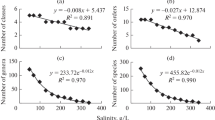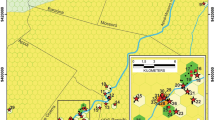Abstract
The specialised aquatic hypogean, i.e. stygobiotic, fauna has been recognised in some regions moderately rich. Slovenia, the broader Dinaric region, and Europe are particularly rich with about 7–8% of all Metazoa and about 40% of Crustacea species being stygobionts. The hypogean biotic diversity is in general predominantly a crustacean diversity. The high number of stygobiont Crustacea–Malacostraca species can be explained by the near absence of Insecta as well as by their high endemicity and sometimes additional specialisation, i.e. the spatial and ecological partition of the environment by the species. Although one cave system may exceptionally shelter up to 40 stygobiont species, they are distributed there into separate associations. Among more than 2000 described stygobiontic Malacostraca species, which include close to 950 Amphipoda, the species numbers within some genera are very high (e.g. Niphargus with 275 spp.). With 10 orders represented the higher taxonomic diversity of stygobiont Malacostraca matches that of fresh waters or the sea. Comparison of some faunas shows that the limiting factors for biodiversity might be the lower ecological diversity of habitats and restricted food resources underground, both brought about to a high degree by the darkness and absence of plants. Being K-strategists, stygobionts are endangered by any sudden changes in their environment. In the case of an increased food input by modest organic pollution, they can be outcompeted by energetically demanding but competitively stronger recent immigrants from surface.
Similar content being viewed by others
References
Barnard JL and Barnard CM (1983) Freshwater Amphipoda of the world. Hayfield Associates, Mt Vernon
Bole J, Drovenik B, Mršić N and Sket B (1993) Endemic animals in hypogean habitats in Slovenia. Naše Jame [Our Caves] 35(1): 43–55
Botosaneanu L (ed) (1986) Stygofauna mundi. EJ Brill/Dr W Backhuys, Leiden
Bowman TE (1981) Thermosphaeroma milleri and T. smithi, new sphaeromatid isopod crustaceans from hot springs in Chihuahua, Mexico, with a review of the genus. Journal of Crustacean Biology 1(1): 105–122
Bowman TE and Abele LG (1982) Classification of the recent Crustacea. In: Abele LG (ed) The Biologyof Crustacea 1: 1–27
Brancelj AS (1987) Cyclopoida and Calanoida (Crustacea, Copepoda) from the Postojna-Planina Cave System (Slovenia). Biološki Vestnik 35(1): 1–16
Brusca RC and Wilson GDF (1991) A phylogenetic analysis of the Isopoda with some classificatory recommendations. Memoirs of the Queensland Museum 31: 143–204
Chesson P (1991) A need for neeches? Trends in Ecology & Evolution 6(1): 26–28
Culver DC, Kane TC and Fong DW (1995) Adaptation and Natural Selection in Caves. Harvard University Press, Cambridge
Danielopol D and Rouch R (1991) L'adaptation des organismes au milieu aquatique souterrain. Reflexions sur l'apport des recherches ecologiques recentes. Stygologia 6(3): 129–142
Dercourt J, Zonenshain LP, Ricou L-E, Kazmin VG, Le Pichon X, Knipper AL, Grandjacquet C, Sbortshikov IM, Geyssant J, Lepvrier C, Pechersky DH, Boulin J, Sibuet J-C, Savostin LA, Sorokhtin O, Westphal M, Bazhenov ML, Lauer JP and Biju-Duval B (1986) Geological evolution of the Tethys belt from the Atlantic to the Pamirs since the Lias. Tectonophysics 123: 241–315
Gaston KJ and David R (1994) Hotspots across Europe. Biodiversity Letters 2: 108–116
Gerasimov IP, Baranov AN, Davitaia FF, Filippov YV, Budyko MI, Lavrenko EM, Muratov MV and Senderova GM (eds) (1964) Fiziko-geografičceskii atlas mira. Akad. Nauk and Gl. Upr. Geod. Kartogr. GGK SSSR, Moskva
Holsinger JR (1978) Systematic of the subterranean amphipod genus Stygobromus (Crangonyctidae), Part II: Species of the Eastern United States. Smithsonian Contributions to Zoology 266: 1–144
Howarth FG (1981) Non-relictual terrestrial troglobites in the tropical Hawaian caves. Proceedings of the eighth international Congress of Speleology, Bowling Green, pp 539–541
Illies J (ed) (1978) Limnofauna europaea, pp I–XVII, 1–532. Fischer G, Stuttgart
Karaman S (1931) 4. Beitrag zur Kenntnis der Suesswasseramphipoden. Glasnik skopskog naučnog Društva 9: 93–107
Karaman G and Ruffo S (1986) Amphipoda: Niphargus-group (Niphargidae sensu Bousfield, 1982). In: Botosaneanu L (ed) Stygofauna mundi, pp 514–534
Karaman G (1993) Crustacea Amphipoda di acqua dolce. Fauna d'Italia. Edizione Calderini, Bologna
Malard F, Reygrobellet J-L, Mathieu J and Lafont M (1994) The use of invertebrate communities to describe groundwater flow and contaminant transport in a fractured rock aquifer. Archiv fuer Hydrobiologie 131: 93–110
Matvejev S (1961) Biogeografija Jugoslavije (Biogeography of Yugoslavia). Monographies 9, Biol Inst. Srbije NR, Beograd
Melik A (1958) Jugoslavija. Tiskovna zadruga, Ljubljana
Notenboom J (1988) Phylogenetic relationships and biogeography of the groundwater-dwelling amphipod genus Pseudoniphargus (Crustacea), with emphasis on the Iberian species. Bijdragen tot de Dierkunde 58(2): 159–204
Notenboom J, Plenet S and Turquin MJ (1994) Groundwater contamination and its impact on groundwater animals and ecosystems. In: Gibert J, Danielopol DL and Stanford JA (eds) Groundwater Ecology. Academic Press, San Diego, CA
Novak D (1992) Tominčev studenec pri Dvoru in njegovo zaledje [The spring of Tominec near Dvor and its tributary area]. Naše Jame [Our Caves] 34: 63–73
Novak D (1993) Hydrogeological research of the Slovenian karst. Naše Jame [Our Caves] 35(1): 15–20
Peck SB (1998) A summary of diversity and distribution of the obligate cave-inhabiting faunas of the United States and Canada. Journal of Cave and Karst Studies 60(1): 18–26
Prelogović E, Arsovski M, Kranjec V, Radulović V, Sikošek B and Soklić S (1975) Paleogeografska evolucija teritorije Jugoslavije od tercijera do danas. Acta seismologica jugoslavica 2–3: 7–11, maps
Pretner E (1963) Kako zaštititi pećinsku faunu Vjetrenice kod Zavale. III. jugoslavenski speleološki Kongres 169–174
Radovanović M(1932) Wormaldia subterranea n. sp. eine neue in den Hoehlen Jugoslawiens aufgefundene Trichopterenart. Zoologischer Anzeiger 100(3/4): 102–108
Reid JW (1992) Taxonomic problems: a serious impediment to groundwater ecological research in North America. First international Conference for Ground Water Ecology 133–142
Roegl F and Steininger FF (1983) Vom Zerfall der Tethys zu Mediterran and Paratethys. Annales des naturhistorischen Museums in Wien 85/A, 135–163
Rouch R and Danielopol DL (1997) Species richness of microcrustacea in subterranean freshwater habitats. Comparative analysis and approximate evaluation. Internationelle Revue fuer gesammte Hydrobiologie 82(2): 121–145
Rouch R and Danielopol DL (1987) L'origine de la faune aquatique souterraine, entre le paradigme du refuge et le modele da la colonisation active. Stygologia 3(4): 345–372
Sket B (1972) Zaščita podzemeljske favne se ujema življenskimi interesi prebivalstva [Protection of subterranean life consonant with human interests]. In: Zelena knjiga [Green Book], pp 137–140, 164–165. PDS, Ljubljana
Sket B (1964) Oestliche Gruppe der Monolistrini. I. Systematischer Teil. International Journal of Speleology 1(1–2): 163–189, tab. 22–44
Sket B (1969) Ueber einige mit der Evolution der Hohlentiere verbundene Probleme. Actes du IVe Congres international de Speleologie en Yougoslavie (1965) 4–5: 225–230
Sket B (1970) Predhodno poročilo o ekoloških raziskavah v sistemu kraške Ljubljanice [Vorlaufige Mitteilung uber die okologischen Untersuchungen im System des Pivka-Flusses im Karste Sloweniens]. Biološki Vestnik 18: 79–87
Sket B (1977) Gegenseitige Beeinflussung derWasserpollution und des Hohlenmilieus. Proceedings of the 6th international Congress of Speleology (Olomouc 1973) 5: 253–262
Sket B (1979) Jamska favna Notranjskega trikotnika (Cerknica – Postojna – Planina), njena ogroženost in naravovarstveni pomen [The cave fauna in the triangle Cerknica – Postojna – Planina / Slovenia /, its conservational importance]. Varstvo Narave, Ljubljana 12: 45–59
Sket B (1980) Bogastvo in ogroženost jamske favne v področju Popovega polja [The richness and threateness of the cave fauna in the Popovo polje region]. 7. jugoslavenski speleološki Kongres., Hercegnovi 1976: 403–409
Sket B (1981) Niphargobates orophobata n. g., n. sp. (Amphipoda, Gammaridae s.l.) from cave waters in Slovenia (NW Yugoslavia). Biološki Vestnik 29(1): 105–118
Sket B (1985) Why all cave animals do not look alike – a discussion on adaptive value of reduction processes. NSS Bulletin 47(2): 78–85
Sket B (1986a) Evaluation of some taxonomically, zoogeographically, or ecologically interesting finds in the hypogean waters of Yugoslavia (in the last decades). Communications, 9. Congreso internacional de Espeleologia 1: 126–128
Sket B (1986b) O favni v Križni jami [Fauna of the cave Križna jama]. Notranjski Listi 3: 25–27
Sket B (1990) Is Niphargobates lefkodemonaki sp. n. (Crustacea: Amphipoda) from Kriti (Greece) a zoogeographical enigma? Zoologische Jahrbuecher, Abteilung Systematik 117: 1–10
Sket B (1992) Conservation of sites important for their hypogean aquatic fauna. A proposal Bulletin de la Liaison de la Societe de Biospeologie 19: 23–26
Sket B (1994) Distribution of Asellus aquaticus (Crustacea: Isopoda: Asellidae) and its hypogean populations at different geographic scales, with a note on Proasellus istrianus. Hydrobiologia 287: 39–47
Sket B (1996a) Biotic diversity of hypogean habitats in Slovenia and its cultural importance. Biodiversity – International Biodiversity Seminar, UNESCO, Gozd Martuljek, Proceedings, pp 59–74
Sket B (1996b) The ecology of the anchihaline caves. Trends in Ecology & Evolution 11(5): 221–225
Sket B (1997a) Distribution of Proteus (Amphibia: Urodela: Proteidae) and its possible explanation. Journal of Biogeography 24: 263–280
Sket B (1997b) The anchihaline habitats, a dispersed ‘center’ of biotic diversity. Conservation and Protection of the Biota of Karst, Karst Water Institute, Special Publication 3: 98–104
Sket B (in press) High biodiversity in hypogean waters and its endangerment – situation in Slovenia, Dinaric karst, and Europe. Crustaceana 72(8)
Sket B and Bole J (1982) Organisms as indicators of hypogean water connections. Naš Krš (Sarajevo) 6(12–13): 115–117
Sket B, Bole J, Benović A, Brancelj A, Brglez J, Čuček M, Ćurčić B, Jaklin A, Karaman G, Katavić I, Kerovec M, Kos I, Legac M, Mršić N, Malej A, Novak T, Petkovski S, Petkovski T, Polenec A, Potočnik F, Pujin V, Radujković B, Števčić Z, Tarman K, Travizi A, Velikonja M, Velkovrh F, Vidaković J and Zavodnik D (1991) Bogastvo in raziskanost jugoslovnske favne: nižji nevretenčarji (Metazoa Invertebrata, ex. Insecta) [Richness and state of knowledge of the fauna of Yugoslavia: lower invertebrates (Metazoa: Invertebrata, ex. Insecta)]. Biološki Vestnik 39(1–2): 37–52
Sket B and Velkovrh F (1981) Podzemeljske živali v termalnih vodah (Subterranean animals in thermal waters). Biološki Vestnik 29(2): 91–120
Stoch F (1995) The ecological and historical determinants of crustacean diversity in groundwaters, or: why are there so many species? Memoires de Biospeologie 22: 139–160
Stock J (1977) The taxonomy and zoogeography of the hadziid Amphipoda with emphasis on the West Indian taxa. Studies of the Fauna of Curacao and other Caribbean Islands 55: 1–130
Turk-Prevorčnik S and Blejec A (1998) Asellus aquaticus infernus, new subspecies (Isopoda: Asellota: Asellidae), from Romanian hypogean waters. Journal of Crustacean Biology 18(4): 763–773
Vandel A (1964) Biospeologie – la biologie des animaux cavernicoles. Gauthier-Villars, Paris.
Ward JV and Voelz NJ (1998) Altitudinal distribution patterns of surfacewater and groundwater faunas. In: Bretschko G and Helešic J (eds) Advances in River Bottom Ecology, pp 135–142
Wicksten MK (1996) Parhippolyte cavernicola, new species (Decapoda: Caridea: Hippolytidae) from the tropical eastern Pacific, with taxonomic remarks on the genera Somersiella and Koror. Journal of Crustacean Biology 16(1): 201–207
Wraber M (1969) Pflanzengeographische Stellung und Gliederung Sloweniens. Vegetatio 17: 176–199
Author information
Authors and Affiliations
Rights and permissions
About this article
Cite this article
Sket, B. The nature of biodiversity in hypogean waters and how it is endangered. Biodiversity and Conservation 8, 1319–1338 (1999). https://doi.org/10.1023/A:1008916601121
Issue Date:
DOI: https://doi.org/10.1023/A:1008916601121




